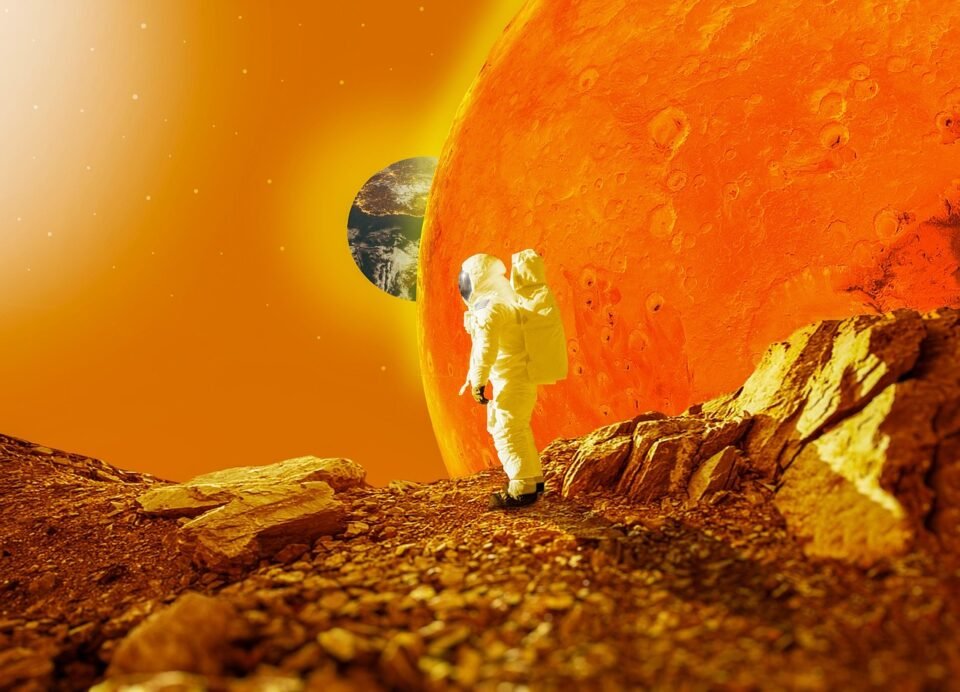Exploring the Solar System: A Journey Through Our Cosmic Neighborhood
By Lateefat
Floating gently through the deep black sky, she would have sworn that everything is silent if not for the soccer ball like object sitting like a royal crown and spinning balls of fire, rock, gas and ice, some glowing, some hidden in shadow, all dancing in a grand cosmic circle. At the center of everything is the Sun, a massive ball of burning gases. It blazes with light so bright; it will blind your eyes if you look directly at it. ” The heat from the Sun will burn your skin if you stay too long in it, even from millions of kilometers away!”, she thought.
The heat emanating from the sun shouted in bold written italics, “Welcome to the solar system, our celestial home in the vast universe”. Staring at the view, Selita realized that what was before her is more than the description Mr. Told had given them in their Basic science class. It’s more than just the Sun and a bunch of planets. It’s a magnificent, living science lab filled with mystery, beauty, and wonder. “Let’s take a sensory trip through it together”, she heard a soft whisper.
Savoring this latest information, she swirled in her astronaut gear to explore further.
Coming upon the sun, the Fiery Heart of the Solar System, it feels like standing in front of a gigantic fireplace that never turns off. “The sun’s warmth touches your skin every day, even when the clouds try to hide it. It lights up our mornings, gives energy to plants, and keeps all the planets in orbit with its strong gravitational pull”, the invisible narrator chipped in. Scientifically, the Sun is a yellow dwarf star, made mostly of hydrogen and helium. It is the main power source of the solar system. “Without it, Earth would be a frozen ball of darkness”, she thought dismayed.
The Planets is a Family of Worlds. Surrounding the Sun are eight unique planets, each with its own character, texture, color, and smell (yes, some planets would actually stink!). “Let’s move further on our exploration of the solar system”, Selita’s invisible companion urged. Mercury, ‘The scorched Rocky Ball’. Mercury is dry and lifeless, with a surface full of sharp craters and rocky ridges. It’s the closest to the Sun. So, standing here would feel like touching a hot metal pan right off the stove. There’s no air, no water, just dead silence and boiling heat during the day, and icy coldness at night.
Do you know why the Venus is called ‘The Earth’s Fiery Twin’?
Venus may look pretty with its bright yellowish glow, but it’s a hostile beauty. The air is thick with poisonous gases, and the surface is hot enough to melt lead. If you step on Venus, you’d be crushed and cooked at the same time. Yuck! The sky would look orange and cloudy, and the air would smell like rotten eggs because of sulfuric acid.
Selita floated to the next object. Ah, home, sweet home! I love to call Earth ‘The Blue Marble’ because it is a perfect balance of cool air, rushing water, rustling trees, and living creatures. You can taste the rain, feel the breeze, hear birds sing, smell the flowers and see them dance on the field. No other is so full of life and sound as planet earth. Earth is the only place in the solar system where your senses come alive in harmony with others.
Mr. Mars ‘The Dusty Red Desert’
The dry, red desert covered in fine dust and Rocky Mountains Mr. Mars. The wind here can whip the dust into huge storms that block out the Sun. The ground crunches under your boots and the air is too thin to breathe. If you scratch and sniff a Mars rock, it might smell like gunpowder or rusty iron.
In addition, Jupiter the Giant Gas King is the biggest planet. It is a giant made mostly of swirling gas. If you could fly through it, you can’t stand on it. You’d feel like you’re floating in a massive stormy cloud. The famous Great Red Spot that is the gas is a giant raging storm that’s been blowing for centuries. Jupiter’s atmosphere is full of electric flashes, icy particles, and strange chemical smells like ammonia.
Let’s visit Saturn ‘The Ringed Wonder. Saturn is the elegant planet with glowing rings made of ice and rock. Imagine ice cubes spinning around a golden ball. That’s what it looks like. If you could hear it, Saturn’s rings would sound like gentle clinks of crystal as they move. The planet itself is cold, windy, and mostly gas. You can’t land on it, but you’d be amazed just looking at its shimmering rings.
Nobody had been able to unravel the Icy tilted mystery of Uranus. Uranus is a cold, pale blue world that rolls on its side and made of ice and gas. If you get close, you will get a sniff of sharp stinky odor like bad eggs or sewer gas. That’s methane in its atmosphere. Uranus is extremely cold and silent, like walking in a freezer the size of Earth.
Here comes Neptune, the Deep Blue Storm World. Neptune is the farthest planet, and it’s a world of deep, dark blue. Winds blow faster here than anywhere else in the solar system, more than 2,000 km/h! If sound could travel in Neptune’s gas, you’d hear a terrifying, whistling roar. The cold bites your skin, and the blue clouds swirl like icy ocean waves.
Neptune lies a region called the Kuiper Belt, full of icy rocks and tiny world lets. One of them is Pluto, once considered the ninth planet. Pluto is small, cold, and lonely, like a frozen marble in the dark. Its surface is covered in ice and frozen nitrogen. It’s so far from the Sun that daylight looks like a dim twilight. It is also called Dwarf planets and beyond. Other dwarf planets like Eris, Haumea, and Makemake float in this region, along with comets that occasionally streak across our sky, leaving glowing trails that dazzle our eyes.
Trailing the shadow of the invisible being, Selita saw the Moons, Asteroids, and Comets. The solar system isn’t just planets. It’s also filled with:
Moons: Like our Moon, which glows silver in the night sky and lights up the dark.
Asteroids: Rocky leftovers from planet formation. If you touch one, it will feel like rough, cracked stone.
Comets: Icy visitors from the outer solar system. When they get close to the Sun, their ice turns into glowing gas that forms a shimmering tail.
Unlike you who was chosen by the Grand Master to enjoy these sights, people cannot travel to most planets yet, but they can explore through spacecraft, telescopes and satellite images. These pictures let us see the golden rings of Saturn, the storms of Jupiter, and the icy plains of Pluto as if we were there. When you look up at the night sky and see stars twinkling or planets shining faintly, it’s like peeking into a cosmic painting filled with motion, silence, and the hum of science at work.
“But why does the solar system matters?” asked Selita.
Having firsthand knowledge of the solar system will inform people on how planets are formed; how Earth is different from other worlds; where life might exist beyond Earth; how gravity, light, and motion work in space. It also reminds us of how tiny we are and how special the Earth is.
“Wow! I can’t absorb all of these at once. I need to digest it.” Sensing a smile on the lips of her invisible friend, Selita closed her eyes and imagined that the group of planets are moving fast and furiously with hot blazing heat from the sun. Gradually, she opened her eyes only to find herself on the living room couch, sprawled midway in and out of the chair with her head resting heavily with spittle all over her face. Selita yawned, stretching lazily as she glanced at the wristwatch that glued to her body like a snakeskin. So, it was just a dream. All that the Invisible told her about the solar system were true. Astronomists can testify to this. But who is Mr. Told?
you can also read: What is Astronomy and who does it?


